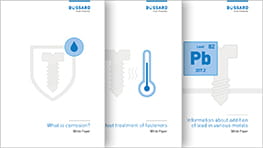Whether for quality assurance, damage analysis, or goods receipt checks, spectral analysis is one of the most important test procedures in the metal-processing industry. Bossard’s testing laboratories have wide-ranging expertise in the spectral analysis of metals and can assist you by applying their expertise and state-of-the-art OES equipment.
Spectral analysis - An effective method for quality control
What is spectral analysis?
Spectral analysis is a materials-testing procedure used to determine the chemical composition of metals. The method is also referred to as optical emission spectrometry (OES) and plays an important role in the metal-processing industry.
In addition to quality control, the test procedure also has applications in the analysis of damage to metallic components, as well as in documentation and in providing the evidence needed to meet qualitative, normative or legal requirements. The procedure also paves the way for largely automated sorting of metals.
In the context of positive material identification (PMI), metal-processing companies also use spectral analysis to check components against materials-engineering criteria.
How spectral analysis works
Spectral analysis takes advantage of the effect whereby photons are emitted during the vaporization of metallic materials. The tester begins by applying an electrode to the metal sample in order to heat it up to a temperature of several thousand degrees. As a result of the potential gradient between the electrode and the sample, an arc is then struck, leading to localized vaporization of the material.
The excitation of atoms in the material vapor results in the formation of a light-emitting plasma, and it is this light emission that underpins the spectral analysis of metals: a diffraction grating separates the emitted light into its constituent spectrum, and detectors measure the intensity of the wavelengths. These intensity readings can ultimately be used to determine the concentration of metallic elements in the sample.
Materials testing by spectral analysis
Spectral analysis allows metal-processing companies to determine the precise proportions of different metallic materials in a sample. This allows the unambiguous identification of materials, or rather of their composition.
Another important application is in positive material identification (PMI); it is possible to avoid costly material mix-ups thanks to spectral analysis and to ensure the seamless traceability of components. Metal-processing companies use PMI testing primarily for safety-relevant components in order to reduce the risk of mix-ups with serious consequences.
The determination of material proportions by spectral analysis is possible for a whole series of metallic elements, including:
- iron
- aluminum
- nickel
- copper
- titanium
- cobalt
- magnesium
- zinc
Spectral analysis – materials testing and many other applications
Spectral analysis is a very popular technique with metal-processing companies, not least thanks to its versatility. The test procedure offers advantages in, among others, the following applications:
- testing of material quality as part of goods receipt checks
- analysis of damage to metallic components
- testing of metallic components prior to part production
- precision analysis in steel production
- material analysis as part of quality assurance
- preparation of professional documentation, certificates and evidence relating to material composition
Bossard – a specialist in spectral analysis
As an experienced specialist in fastening and materials technology, we have the necessary expertise to assist you with spectral analysis-based test procedures in line with your requirements. At our testing laboratories, we use our modern OES equipment to carry out services including the following on your behalf:
- spectral analysis of metals
- preparation of certificates, evidence, and documentation
Contact our experts and learn more about Bossard's Expert Test Services. We are happy to hear from you!
Discover other modules that contribute to improving your productivity step by step
![]() Expert Education
Expert Education
Learn about the essentials and secrets of fastenings in our seminars and e-learning courses
![]() Expert Teardown
Expert Teardown
Identify the best fastening solution and cost saving potential for you
![]() Expert Design
Expert Design
Design your best product with a wide range of technical information and tools
Expert Walk
Study your fasteners and tools in use, we determine how to proceed leaner and smarter
![]() Expert Assortment Analysis
Expert Assortment Analysis
Reduce TCO by identifying opportunities for fastener rationalization


